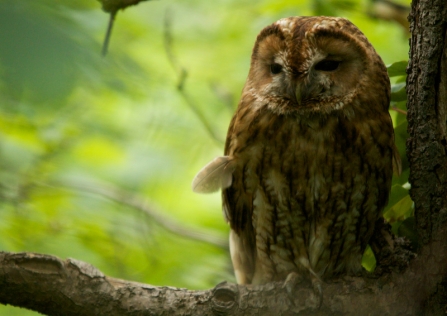
Tawny owl by Tom Hibbert
Short-eared owl by Danny Green/2020VISION

Tawny owl by Tom Hibbert
The insistent ‘twit-twoo’ you may hear during the evening is a tawny owl call, but it doesn’t come from just one owl. It is actually two owls talking to one another: the female calling ‘twit’ (or more accurately, ‘kee-wick’) and the male calling ‘twoo’, which is actually more of a ‘hoohoo’ sound. Listen to the clip below and see if you can separate the female and male calls.
Tawny owls live in parks and woodlands in areas where there are plenty of small mammals, frogs, insects and worms to eat. It’s thought that established pairs never leave their territories, which means that if you see or hear tawny owls in the same spot regularly it’s likely they are the same pair.
Where to see tawny owls:
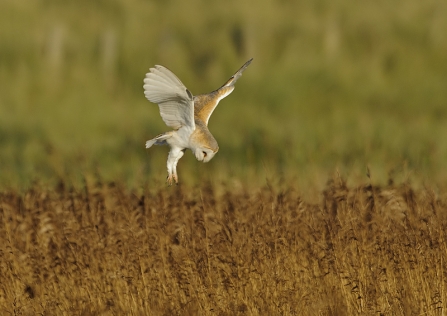
John Bridges
Undoubtedly the most recognisable owl species in the UK, the barn owl cuts a ghostly figure as it quarters fields at dusk. It has a heart-shaped face, a white underside and a golden back flecked with slate grey – gorgeous!
Unlike the tawny owl, barn owls don’t venture into more urban settings and are most likely seen out in the countryside, hunting along field edges and riverbanks close to their roosts in agricultural buildings, nest boxes, barns and tree cavities. They also have very different calls to tawny owls, letting go an unearthly screech. Listen below and see if you can tell the difference.
Where to see barn owls:
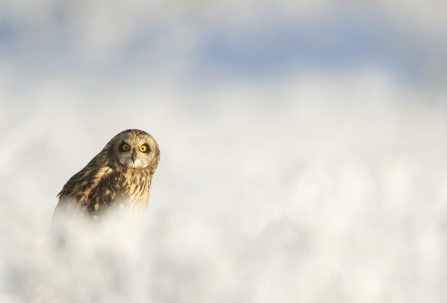
Short-eared owl by Danny Green/2020VISION
Despite us having fewer short-eared owls in the UK than species like the tawny owl, ‘shorties’ are actually one of the easiest to see as they hunt during the daytime. Their big amber eyes, satellite-dish face, and black and gold colouring are unmistakeable and completely beautiful.
Perfect short-eared owl habitat during spring and summer can be found on healthy uplands with plenty of voles and other small mammals to feed on. Here, the owls nest on the ground amongst the heather. During winter, however, they move to wetlands and coastal marshes where they are met by an influx of continental birds from Scandinavia, Russia and Iceland, giving you a much better chance of spotting one. Most short-eared owl sightings at this time of year come from our Lunt Meadows reserve.
Where to see short-eared owls:
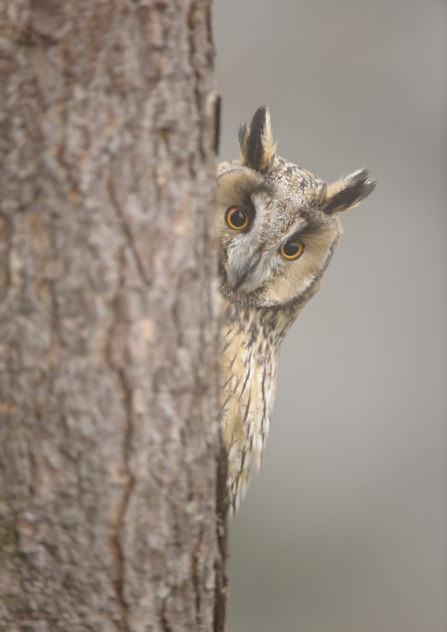
Long-eared owl by Andrew Mason
Did you know that long-eared owls don’t actually have ears? They are tufts of feathers that the owls raise when alarmed. Long-eared owls are a little smaller than woodpigeons but look much larger when they feel threatened; making themselves look tall, thin and intimidating.
Unlike the obliging short-eared owl, you are incredibly unlikely to see a long-eared owl in flight. Despite having the orange eyes typical of a day-flying owl they are nocturnal and secretive, hunting small mammals in the dead of night. Your best chance of seeing one comes during winter when the birds migrate to warmer counties in the south, often resting along the coast. You could also spot one leaving or returning to a communal roost in well-wooded countryside. Their funny ‘hoo-oo’ call (heard below) is usually what gives them away.
Where to see long-eared owls:
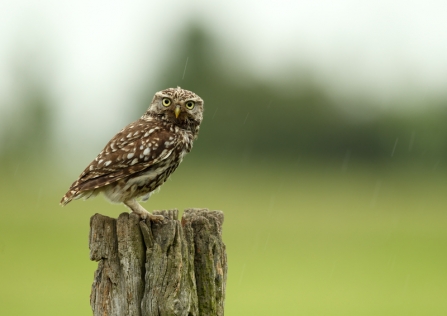
Little owl by Luke Massey/2020VISION
The characterful little owl isn’t actually native to the UK – it was introduced from Europe back in the 19th century. This species is tiny (less than half the size of a tawny owl!) but what it lacks in stature it makes up for in personality.
Little owls are largely farmland birds that hunt in fields during the day, chasing beetles and other insects along the ground and pulling up worms from the soil, though they’ll also eat reptiles, amphibians and small mammals. Little owls are most often seen perching on poles, rocks and tree branches, staring grumpily as you pass by.
Where to see little owls:
There is one more owl that has historically been seen close to Lancashire, though it’s been a couple of years since the last sighting. I am, of course, talking about the eagle owl.
North Yorkshire birders reported sightings of these huge owls back in 2010. They are usually only seen in northern Europe, with UK populations thought to have escaped or been released from captivity.
The Forest of Bowland eagle owls are thought to have nested successfully in 2016, but since then the birds seem to have mysteriously disappeared.
Are you ready to get outside and go owl-spotting? Click the button below to find a special wild place near you.